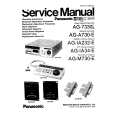|
|
|
Kategorie
|
|
Informacje
|
|
Polecamy
|
|
|
 |
|
|
Dla tego produktu nie napisano jeszcze recenzji!
 ;
Dokładna dokumentacja, pomogła w szybkiej naprawie telewizora. Dziękuję!
 ;
jedyne do czego mogę mieć zastrzeżenie to jakość zdjęć zawartych w przesłanej instrukcji serwisowej ponieważ są fatalnej jakości, praktycznie nieczytelne. tak poza tym jestem zadowolony to jest to czego szukałem.
 ;
Wszystko w porządku.
Instrukcja czytelna i kompletna.
Dziękuję.
all right!
thank you.
 ;
Bardzo dobra instrukcja. Zawiera wszystko co potrzeba, polecam!
 ;
Instrukcja jest OK. Schematy czytelne, opisane niektóre procedury.
2.6 THERMAL HEAD POSITION ADJUSTMENT 2.6.1 Outline The mechanism is designed to be movable by about ±0.4 mm by means of the Head Arm and Heat Sink, and the Thermal Head position can be adjusted by means of the Heat Sink. As a result, an adjustment is required after the Heat Sink has been separated from the Head Arm. The Thermal Head is attached to the mechanism so that only a half of the mechanism can be disassembled unless the Heat Sink is separated from the Head Arm. The remaining half of the mechanism contains the motor and associated parts. Normal printing requires that the Thermal Head press the ink and paper against the optimum position on the Platen Roller. If for example the pressurized point is deviated obliquely, wave or wrinkle patterns will be observed on the print area and the colors become pale. Even when the parallelism of the Thermal Head is maintained, similar symptoms to the above may be observed when it is deviated upward or downward. The phenomenon described above occurs when the Thermal Head is not pressurized against the designated area on the Platen Roller with the designed pressure values being applied. Since the Platen Roller is a simply rotating part, the part to be re-positioned in this case is that of the Thermal Head alone. Assuming that the optimum position is A, Standard paper: A ± 0.25 mm (approx.) The �±� indicates tolerance and the Thermal Head is satisfactory if it is within that tolerance range. In the actual mechanism, the Thermal Head can be moved by about ± 0.4 mm.
0.25 mm Peper exit direction Head Arm Deviation tolerance 0.25 mm
Heat Sink Thermal Head
0.25 mm
1 Center
Assumed to be optimum position A.
0.25 mm
Heat Sink Thermal Head
0.25 mm
2 Toward the paper exit direction
Heat Sink Thermal Head
0.25 mm
2.6.2 Adjustment Procedure Assuming that 1 in Fig. 2-6-1 indicates optimum position A, normal printing may seem to be possible even when the position is deviated up or down like 2 or 3 or obliquely like 4 or 5. However, these figures show only the extreme cases. In actual operation, if the position is deviated as shown in 2, 3, 4 or 5, the deviation may exceed the tolerance. In addition, if it is assumed that 2 indicates optimum position A, cases 3, 4 and 5 exceed the acceptable tolerance and only 1 and 2 fall within it.
3 Apart from the paper exit direction
0.25 mm
Heat Sink Thermal Head
0.25 mm
4 Toward the right oblique direction
0.25 mm
Heat Sink Thermal Head
0.25 mm
5 Toward the left oblique direction
Fig. 2-6-1
2-8
|
|
 |
> |
|





















